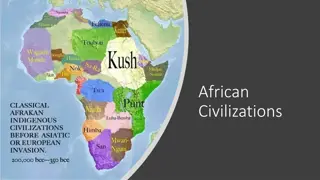Ancient Civilizations and Native American Cultures Overview
Early civilizations like the Olmec, Maya, Inca, Aztec, and North American cultures such as Hohokam, Anasazi, Adena, Hopewell, and Mississippian are explored. The diverse Native American tribes in Mesoamerica, North America, the West, Southwest, Pacific Northwest Coast, Great Plains, Far North, and Eastern Woodlands are examined, highlighting their unique practices, settlements, and innovations.
Download Presentation

Please find below an Image/Link to download the presentation.
The content on the website is provided AS IS for your information and personal use only. It may not be sold, licensed, or shared on other websites without obtaining consent from the author.If you encounter any issues during the download, it is possible that the publisher has removed the file from their server.
You are allowed to download the files provided on this website for personal or commercial use, subject to the condition that they are used lawfully. All files are the property of their respective owners.
The content on the website is provided AS IS for your information and personal use only. It may not be sold, licensed, or shared on other websites without obtaining consent from the author.
E N D
Presentation Transcript
Early Civilizations of Mesoamerica Olmec 1stcivilization in America Mayan calendars based on stars, engineering and mathematics (Yucatan Peninsula) Inca most prominent of these empires. Empire stretched 2,500 miles along the mountainous western coast of South America. (Andes Mountains) Machu Picchu= famous ancient city Aztec conquer other people, huge empire, human sacrifice, tribute Tenochtitlan= Capitol (Mexico City)
North American Cultures Hohokam elaborate system of canals, world s first etchings, decorative pottery, turquoise jewelry Anasazi cliff dwellers Adena mound builders, woodworking tools, built canoes and nets, clay pots Hopewell built geometric earthworks Mississippian new strains of crops, mound builders No longer nomadic, become stationary
Native AmericanWest Southwest: began to leave the cliff sides and build settlements near waterways for irrigational purposes Pueblo Tribe-1300 Built near the Rio Grande for irrigational purposes Pacific Northwest Coast: built totem poles (represents wealth and status) Hunted the ocean for; whales, sea otters, and seals Potlatches=ceremonies where possessions were given away Great Plains: followed buffalo, tamed horses and became great warriors
Native AmericansFar North New inventions to deal with environment Harpoon Dogsled Kayak boots with ivory spikes Use whale oil and blubber for fuel
Native AmericansEastern Woodlands Hardwood forest and rich soil Blended agriculture with hunting and gathering Vast supply of trees lead to using wood for many items Northeast: Slash and burn agriculture; also hunt and fish Live in longhouses and wigwams Relied on wild animals for clothing and food Southeast lived in towns: houses made of mud, thatch or grass women farmed, men hunted Grew corn, crops, and beans
Trading Networks Trade brought tribes in contact with one another Elaborate transcontinental trading network allowing people to trade from all over Trade routes reached from Mexico to the Atlantic coast Land Use- Native Americans did not trade land. (Regarded as the source of life)
Social Organizations Division of labor-the assignment of tasks according to gender, age, or status formed basis for social order The family= basic unit of organization among all Native American groups Clans- or groups of families descended from a common ancestor All families participated in community decision making Families that lived in the grasslands would only reunite to celebrate important occasions
West Africa Established trade system prior to arrival of Europeans mid 1400 s= Europeans arrive Salt and Gold mines Camels Islam arrives from the middle east through trade
Islam Founded in Arabia Muhammad second largest of the three major monotheistic religions Monotheistic= one god Muslims believe that the Quran is God's word as revealed to the prophet Muhammad (570-632 C.E.) through the angel Gabriel.
Portuguese Arrive Established trade post on the West African coast Gold By pass trade route across the Sahara Began the European trade of west Africans Slaves used to grow sugarcane
Early Empires Ghana: West Africa s first empire, empire falls because trade shifts Mali: elaborate government, trade shifts again Songhai- power extended across West Africa Sunni Ali= never lost a battle Askia Muhammad= administrative districts
West Africa Farming, herding, hunting and fishing, Mining and trading Collective ownership of land Skilled at growing rice
Slave Labor Slavery already exist in West Africa Not born in to slavery Not a lifetime punishment Different than slavery in the Americas where slavery continued from generation to generation Not Portuguese original objective
Forest Kingdoms of Guinea Surplus food Traded copper and salt Benin = dominated a large region around the Niger Delta Kongo= West Central Africa Manikango= Oversaw 4 million people Government resembled many of the European governments at the time
Central and Southern Africa Age carried rank with in the family Chief Consulted the council of elders for all decision making events Matrilineal- people traced their lineage through their mother s family Lineage ties determined: Family loyalties Inheritances Marriage























